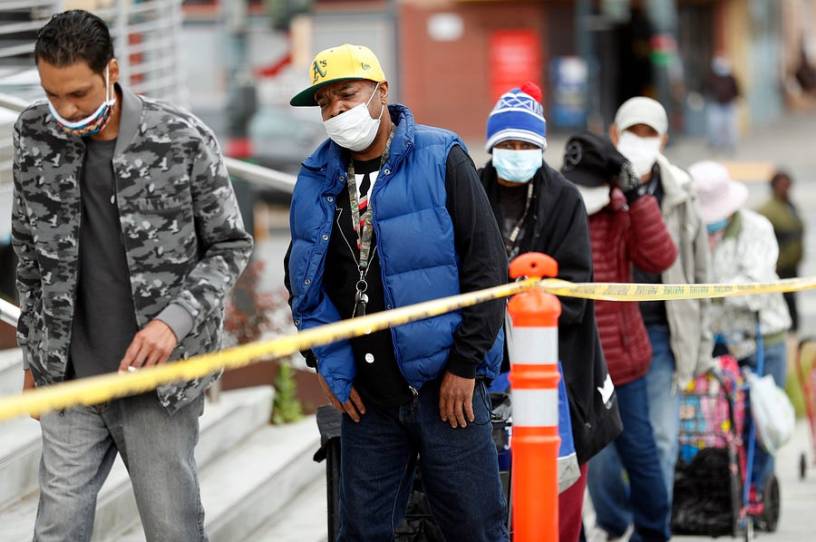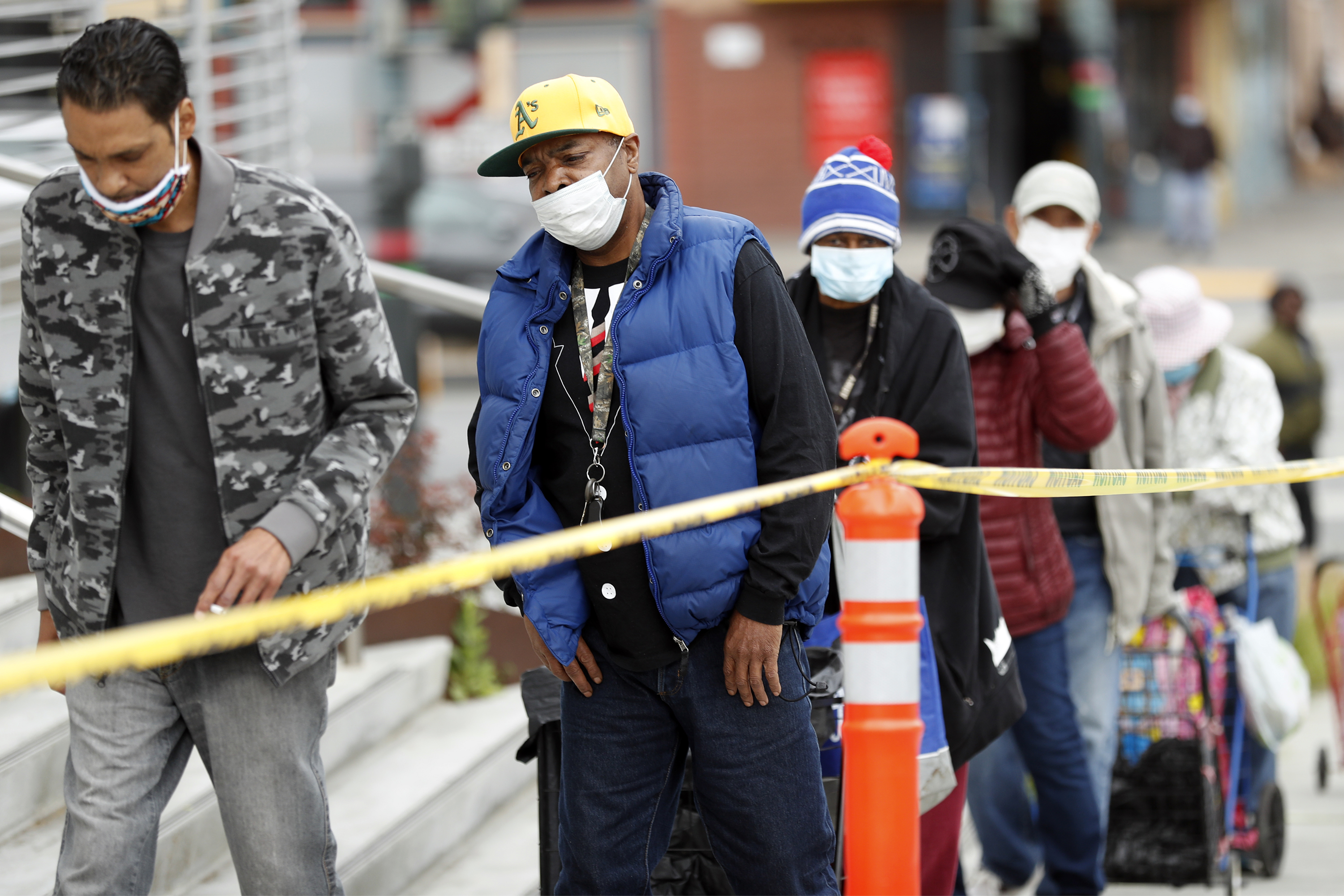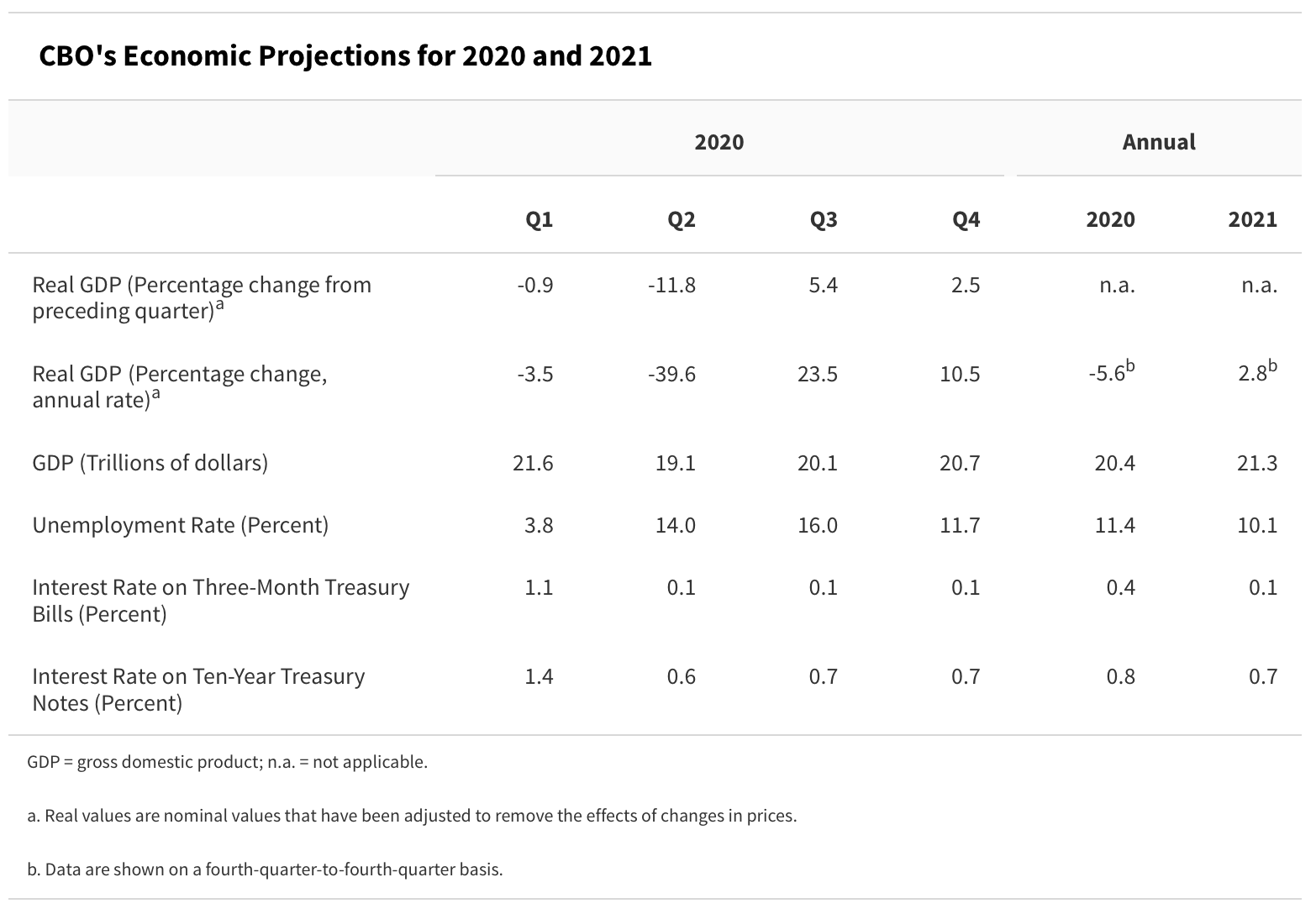The Morning Dispatch: Are We In a Depression?

Happy Monday! If we get anything wrong in this newsletter, rest assured that we are merely being sarcastic.
Today’s newsletter hits on some important topics on the fight against coronavirus, so we wanted to make The Morning Dispatch available to our whole audience. We have “unlocked” this item so that you may share it on social media. Beyond becoming members yourselves, one of the best ways you can help The Dispatch is to let friends, colleagues, and relatives know about us. So, we encourage you to share this widely and forward it to your friends.
Quick Hits: Today’s Top Stories
As of Sunday night, there are now 965,910 confirmed cases of COVID-19 in the United States (up 96,740 over the weekend) and 54,876 deaths (up 4,989 over the weekend), according to the Johns Hopkins University COVID-19 Dashboard, leading to a mortality rate among confirmed cases of 5.7 percent (the true mortality rate is likely much lower due to incomplete testing regimens). Of 5,441,079 coronavirus tests conducted in the United States (780,829 conducted over the weekend), 17.8 percent have come back positive. There are 126,647 Americans hospitalized with COVID-19 complications (an increase of 3,026 over the weekend), and 107,045 have recovered from the virus (an increase of 26,842 over the weekend).
Top Navy officials have recommended that Capt. Brent Crozier be reinstated to his post aboard the USS Theodore Roosevelt, where he was removed from command earlier this month. Crozier had written a letter asking for authorization to evacuate and quarantine his ship because of the threat of COVID-19, and the letter was leaked to the press.
President Trump denied reports that he is considering replacing Health and Human Services Secretary Alex Azar amid the coronavirus pandemic, saying Sunday that Azar is “doing an excellent job.”
Axios is reporting that President Trump is planning to cut back on the daily coronavirus press briefings, appearing less frequently and for shorter periods of time.
New evidence has emerged that appears to support claims made by Tara Reade, a former Senate staffer who has accused former Vice President Joe Biden of sexual assault.
The True Scope of the Virus’ Economic Devastation

So much of the last two months can be summed up in just one word: uncertainty.
Uncertainty over whether this could happen here, and—once it did—how long it will last. Uncertainty over who is most susceptible to the virus’ clutches, and how many will die as a result of it. Uncertainty over furloughs and layoffs, and whether cratering consumer demand will rebound any time soon.
Researchers like Dr. Christopher Murray at the Institute for Health Metrics and Evaluation have attempted to model out the coronavirus’ spread, but—aside from record-setting unemployment claims week-after-week—when it comes to the economic fallout of the virus, we’ve been mostly in the dark. Until now.
The Congressional Budget Office (CBO)—a nonpartisan federal agency that conducts “independent analyses of budgetary and economic issues”—released its latest projections for 2020 and 2021 on Friday, and the topline findings are bleak.
The CBO estimates that real GDP will decline 12 percent in the second quarter of 2020 alone, and the unemployment rate will hover around 14 percent over the same timeframe. The report—written by CBO Director Phillip Swagel—finds the federal budget deficit will likely rise to $3.7 trillion for fiscal year 2020 (17.9 percent of GDP) and $2.1 trillion in 2021 (9.8 percent of GDP), assuming no additional emergency spending. The budget deficit was $984 billion (4.6 percent of GDP) in 2019.

By most measures, the CBO expects the bulk of of the economic fallout to occur in the second quarter and foresees modest improvements—annualized economic growth of 17 percent in the second half of the year—in Q3 and Q4. But that still amounts to GDP shrinking 5.6 percent on the year.
Although the U.S. unemployment rate was under 4 percent at the start of the year, the CBO doesn’t expect it to fall under 10 percent again until the end of 2021 at the earliest. And perhaps even more damaging long-term, it projects the labor force participation rate (the number of people either working or actively looking to work) to fall from 63.2 percent at the beginning of 2020 to 59.8 percent in Q3.
Treasury Secretary Steve Mnuchin pushed back on some of these numbers in a Fox News interview with Chris Wallace on Sunday, projecting that the economy is going to “really bounce back” in July, August, and September. “We are putting in an unprecedented amount of fiscal relief into the economy,” Mnuchin added, referencing the stimulus checks, enhanced unemployment insurance, and the Paycheck Protection Program. “I think this is going to have a significant impact.”
When pressed by Wallace on the CBO report, Mnuchin again struck a rosier tone. “This is a scenario where we’ve closed the economy and we’re going to open the economy. So all these models are based upon health assumptions, how quickly we reopen, so we’ll see,” he said. “My own opinion is, again, we have unprecedented amount of liquidity in the system. … As businesses begin to open, you’re going to see demand side of the economy rebound.”
The CBO has certainly gotten some things wrong in the past, and the report itself acknowledges its projections are “subject to enormous uncertainty.” To model the economic effects of something as complex as an international pandemic, the agency had to make some assumptions as to the length of current social distancing measures (through June) and the potential re-emergence of the virus (through the first half of 2021). “Since social distancing began in early March,” the CBO report reads, “new information has generally suggested a worsening outlook, and private-sector forecasts have been revised repeatedly in that direction. CBO’s projections fall within the wide range of views in those private forecasts but are closer to those that show greater near-term economic weakness.”
COVID Clotting
In the midst of the debate about how and when we should begin to reopen our economy, it can be easy to forget the central salient point of the whole coronavirus crisis: It might feel like we’ve been dealing with it for ages, but we are still early in the fight against this disease. It isn’t just that we don’t know how to treat coronavirus yet—in a very real sense, we still don’t even know what it does.
That point has been driven home by doctors’ increasing awareness over the last few weeks of an unnerving pattern among coronavirus patients: They were experiencing blood clots at extraordinarily high rates, often leading to health problems beyond the respiratory issues that are COVID-19’s primary trademark.
The exact cause of this clotting is not yet known—whether it’s an effect of the virus itself or a byproduct of the body’s haywire immune response to it. The picture is further complicated by the fact that blood clotting is a common risk in patients sick enough to be hospitalized.
The presence of abnormal clotting in severely ill COVID-19 patients was remarked upon as early as March by doctors treating the disease in China, who noted that many tiny clots would form in the small vessels of major organs including the heart, liver, and kidneys. But many COVID doctors say that they’re seeing startlingly high amounts of clotting even in younger and more stable patients who seemed unlikely to die from respiratory duress alone. According to a Washington Post report over the weekend, this has corresponded with a rise in serious strokes even among some younger people who were not previously aware they had the disease at all.
“I’ve heard stories of where we draw the blood from the patients—usually you have maybe a minute to put the blood in the test tube before it starts to clot, and it’s like clotting as we draw it,” one New York doctor who has been treating hospitalized COVID patients told The Dispatch. “There’s cases where the patients seem to be doing fine in terms of the virus, and are getting better, and all of a sudden they can’t breathe, and we look and find a blood clot in the lungs.”
One routine blood test run to test for clotting is the D-dimer test, which checks for fragments of a protein of broken-down clots in the blood. A higher result on the test is not always proof positive of clots—it can sometimes signal other serious medical problems, or register higher with the patient’s age. But while not all patients are exhibiting clotting-related problems, a very high number are returning very high D-Dimer results.
“Most of these patients, it’s high,” the doctor said. “And not just like a little bit high, because that could be just from being really sick. But it’s high to the point where, you know, we expect to find a clot … What we wind up doing is, if D-dimer is abnormal, we have to assume they have a clot somewhere or lots of little clots that we can’t see and we just have to give them the blood thinner.”
Where’s the Beef?
As restaurants and schools have shuttered across the country, there has been no shortage of reports on the tens of millions of pounds of food going to waste in fields. At the same time, social media has been filled with photos of cars lined up for miles outside food banks as out-of-work families struggle to get food on the table.
One study released last week found that “nearly all food banks reported an increase in demand for assistance compared with last year, with an average increase of 70 percent.” Drive-thru locations that were set to handle 200 to 250 cars per day are now trying to serve 1,200 cars in lines that stretch to five miles and longer. At the same time, food banks are receiving fewer donations. The Greater Chicago Food Depository reported that “it received only 1.83 million pounds of donated food from non-government sources last month—a 30% decrease from what it received a year ago, in March 2019.” And they are doing it all with fewer volunteers to help as older Americans especially are encouraged to stay home. A food bank that services large parts of Texas reported a 70 percent reduction in volunteers.
The results have been particularly disastrous in New York, where one survey found that “more than a third of the city’s food banks have closed for lack of supplies, donations or volunteers” at a time when the number of those in need is predicted to double or triple in the coming weeks.
And yet, farmers and grocery store retailers all agree that the country currently has a food surplus.
One problem is that the USDA has endless regulations on everything from the types of cuts of meat that can be donated to the size of the boxes the food is donated in. The National Potato Council claims that they have “between $750 million and $1.3 billion worth of potatoes and derivative products that are trapped” and could be easily directed to charities and food banks.
For its part, USDA has recently announced “a long-awaited $19 billion aid program with $3 billion set aside to buy excess food.” But changing supply chain routes and packaging processes takes time. And time is running out for both farmers and those in need as the federal government has yet to answer “how food will be transported to where it is needed, and who will pay for the rented refrigerator and freezer trucks necessary to increase storage capacity on-site at food banks.”
In the meantime, many farmers—like those in Florida and California—have been able to help their local food banks with “online clearinghouses to try to match up excess food with need in their area.” Others have gotten creative, including one Idaho potato farmer who “decided to pile [millions of excess potatoes] up outside and invite the public to come take what they’d like for free.” He reports that thousands of people—some from as far as Las Vegas—have shown up to take him up on the offer. But those acts of kindness won’t be enough.
At this point, more than 26 million people have filed jobless claims in recent weeks. Food insecurity will only increase as those numbers rise and farmers across the country will increasingly face their own devastating economic reality as the sources of their incomes literally wilt on the vine.
Worth Your Time
The ripple effects of our economic shutdown are making themselves known throughout the economy, and will only grow clearer as time goes on. This Bloomberg piece details how social distancing has decimated the cut flower industry—weddings and other celebratory occasions are on hold, and flowers are about as perishable a good as there is. The piece doubles as a fascinating examination of the “miracle of modern capitalism” that is the global flower trade—which allows cut flowers to be cut in Africa, whisked away to be auctioned off in Amsterdam, and hustled off to arrive, still dewy-fresh, in your supermarket—and what parts of it will even remain once all this is over. (Speaking of flowers, a reminder that Mother’s Day is less than two weeks away. Understanding that we’re all probably pinching pennies these days, if you’re in a position to double-up on the mums for Mom, you’d make her happy and help growers in trouble.)
Let’s posit up front that the vast majority of D.C. fundraising pitches for citizens to toss their hard-earned cash into the gaping maw of the swamp out of a sense of patriotic vim are a little bit tacky and a little bit gross. With that said, it’s still fair to say that a few distinguish themselves as being particularly tawdry—say, the Trump campaign and Republican National Committee harvesting phone numbers, zip codes, and email addresses from eager patriots on the pretext of signing a HUGE surprise birthday card for the first lady. The Atlantic’s Conor Friedersdorf has the details here.
We can’t recommend this FiveThirtyEight podcast with the aforementioned Dr. Christopher Murray enough. Hosts Nate Silver and Galen Druke talk to Murray about his IHME COVID-19 model: How he deals with uncertainty and missing data, the model’s strengths and limitations, and how the press and the public have misinterpreted the output.
Presented Without Comment
Also Presented Without Comment
Toeing the Company Line
David’s Sunday French Press takes a deep look at the “incredibly powerful pull of tribe over truth.” Noting that he had ancestors who fought for the Confederacy, he writes: “The older I get, the more I’m haunted by their legacy.” Be sure to read the whole thing, but for now, ponder this question that he poses: “If everyone around me is wrong, would I have the wisdom and courage to know and do what’s right?”
If you missed Jonah’s Friday G-File, you missed some choice observations about how it’s predominantly liberal white people who are stressed out that Joe Biden is the Democrats’ 2020 nominee for president, and what that says about the current demographic makeup of the Democratic party.
We really recommend giving this week’s edition of The Dispatch Podcast a listen, despite the fact that it’s tragically David-less and Jonah-less—instead, you get Sarah and Steve conducting a great interview of Jonathan Karl, chief White House correspondent at ABC News, talking about his new book and the latest news from the briefing room—including, uh, some disinfectant-related headlines you may have heard a thing or two about.
On the site today, Danielle Pletka looks at how Donald Trump’s seeming affection for dictators such as Kim Jong-un and Vladimir Putin stands in contrast to how his administration treats them in terms of sanctions and other actions.
Let Us Know
As noted, Mother’s Day is officially less than two weeks away. In a world where hugs and in-person visits might be ill-advised, how are you planning on celebrating the mom(s) in your life?
Reporting by Declan Garvey (@declanpgarvey), Andrew Egger (@EggerDC), Sarah Isgur (@whignewtons), and Steve Hayes (@stephenfhayes).
Photograph by Scott Strazzante/San Francisco Chronicle/Getty Images.